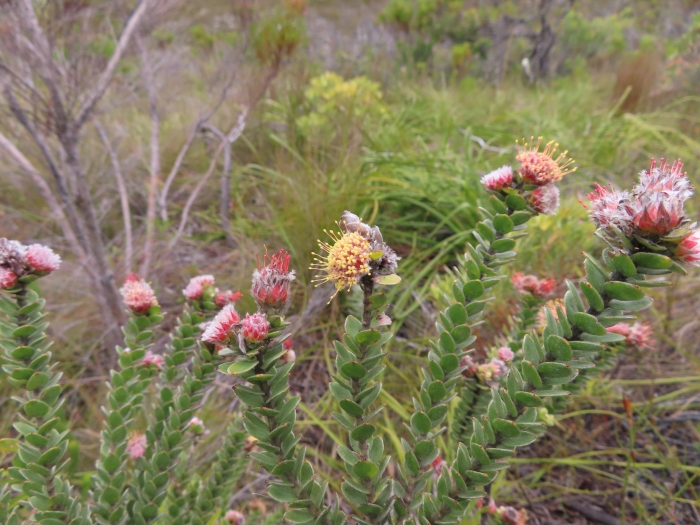Oval-Leaf Pincushion
(Leucospermum truncatulum)
Oval-Leaf Pincushion (Leucospermum truncatulum)
/
/

linkie
CC BY 4.0
Image By:
linkie
Recorded By:
Copyright:
CC BY 4.0
Copyright Notice:
Photo by: linkie | License Type: CC BY 4.0 | License URL: http://creativecommons.org/licenses/by/4.0/ | Rights Holder: linkie | Publisher: iNaturalist | Date Created: 2020-11-25T13:25:17-08:00 |

























Estimated Native Range
Summary
Leucospermum truncatulum, commonly known as Oval-leaf Pincushion, is an evergreen shrub native to the fynbos region of the Western Cape province in South Africa, particularly thriving on east- and southward facing slopes. This species is adapted to the unique ecology of the fynbos, characterized by nutrient-poor, acidic sands and frequent fires. It typically grows to a height of up to 7 feet, with a slender and upright form. The plant produces distinctive small globe-shaped flower heads that start yellow and mature to a pinkish hue, blooming from late winter to spring. The flowers are quite showy and attract a variety of pollinators, particularly insects.
Oval-leaf Pincushion is valued for its ornamental flowers and is used in gardens for its striking appearance and ability to adapt to poor soils. It requires well-drained, acidic soil and full sun to partial shade. While it is drought-tolerant once established, it benefits from occasional watering during prolonged dry periods. In cultivation, it is important to mimic its natural fire-prone habitat by providing low-nutrient soils and avoiding excessive fertilization. The plant is not commonly affected by diseases but can be susceptible to root rot if overwatered. It is not considered invasive and is best suited for Mediterranean-style gardens, rockeries, and as a specimen plant in xeriscaping projects.CC BY-SA 4.0
Oval-leaf Pincushion is valued for its ornamental flowers and is used in gardens for its striking appearance and ability to adapt to poor soils. It requires well-drained, acidic soil and full sun to partial shade. While it is drought-tolerant once established, it benefits from occasional watering during prolonged dry periods. In cultivation, it is important to mimic its natural fire-prone habitat by providing low-nutrient soils and avoiding excessive fertilization. The plant is not commonly affected by diseases but can be susceptible to root rot if overwatered. It is not considered invasive and is best suited for Mediterranean-style gardens, rockeries, and as a specimen plant in xeriscaping projects.CC BY-SA 4.0
Plant Description
- Plant Type: Shrub
- Height: 4-8 feet
- Width: 4-6 feet
- Growth Rate: Moderate
- Flower Color: Orange, Pink, Yellow
- Flowering Season: Spring
- Leaf Retention: Evergreen
Growth Requirements
- Sun: Full Sun
- Water: Low
- Drainage: Fast
Common Uses
Bird Garden, Butterfly Garden, Drought Tolerant, Low Maintenance, Showy Flowers
Natural Habitat
Native to the fynbos region of the Western Cape province in South Africa
Other Names
Common Names: Rocket Pincushion, Rocket-leaved Pincushion
Scientific Names: , Leucospermum truncatulum, Leucadendron buxifolium, Leucospermum buxifolium, Leucospermum buxifolium f. epacrideum, Leucospermum buxifolium subsp. epacrideum, Leucospermum epacrideum, Protea buxifolia, Protea villosa, Protea villosa,
GBIF Accepted Name: